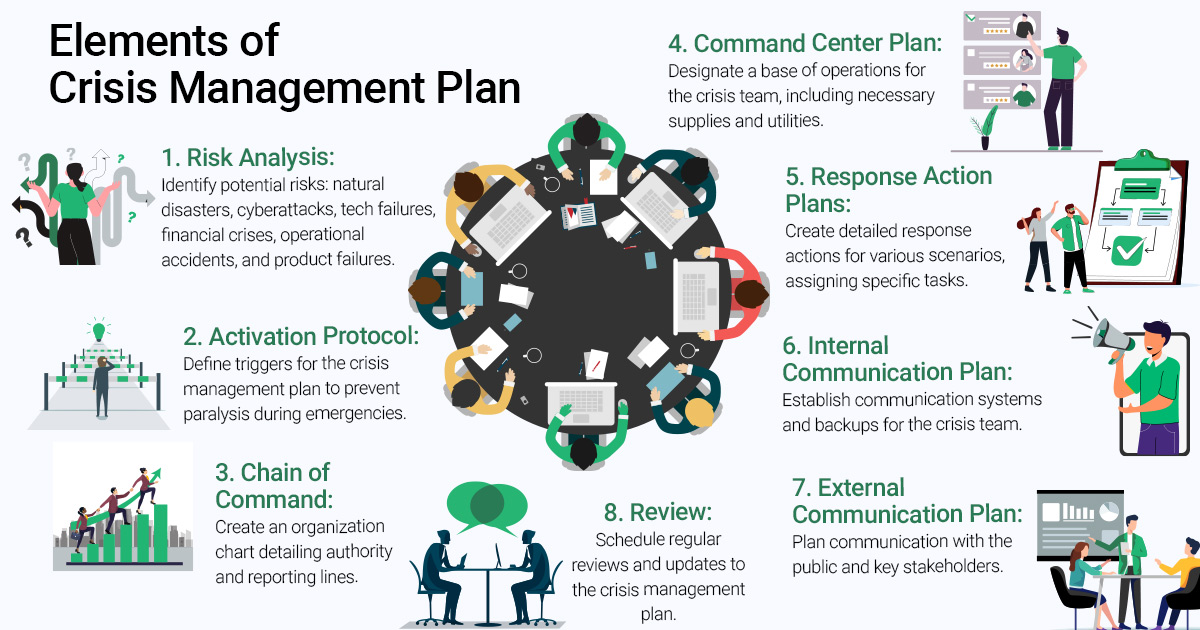
Is your company among the 51 percent that lacks a crisis management plan? If so, it’s crucial to start planning now—the future of your business depends on it. Crises often strike without warning, underscoring the necessity for a robust crisis communication plan in every organization.
So, where should you start? For those new to crisis management, creating a plan can seem overwhelming. However, the advent of Artificial Intelligence (AI) is revolutionizing proactive crisis response. How can AI-powered predictive intelligence solutions transform your crisis communication strategy across all business functions? These solutions ensure that the right stakeholders receive critical project or business information promptly, dramatically improving organizational crisis management and enabling swift, informed decisions during critical events.
AI-powered predictive analytics isn't just for project management. It's revolutionizing operations, finance, HR, and customer service, providing real-time insights and preempting crises before they escalate. Isn’t it time your company used this cutting-edge technology to enhance your crisis preparedness?
This article will explore why you need a crisis management plan, what elements to include, and ways to use AI-powered predictive intelligence in crisis management while ensuring transparency and trust. Let’s understand how every business function can benefit from AI in building a robust crisis management strategy.
What is a Crisis Management Plan?
A crisis management plan outlines your business's strategic response to a crisis, detailing who will be involved and their roles. The primary objective is to mitigate damage and resume normal operations swiftly. Crises can manifest in various forms, often threatening your organization's project execution process and impacting your business operations, reputation, finances, and strategic goals. Your crisis management plan should be a dynamic document that your team can refer to and update regularly. While there are different ways to structure your plan, a common approach is to create a checklist. This allows your team to address the necessary steps during a crisis systematically.

Although predicting a crisis's exact nature and timing is impossible, conducting a risk analysis can help identify potential threats to your organization. For instance, a social media marketing company might be more vulnerable to incidents requiring public apologies, whereas a tech company could face a higher risk of cyberattacks. Understanding your industry's risks enables you to better prepare for and mitigate potential crises.
Why is a Crisis Management Plan Important for Your Organization?
A crisis management plan is essential because, without one, individuals under stress may make poor decisions that inadvertently prolong or worsen a crisis. Swift and effective action is often crucial to an organization's survival.
In the aftermath of a crisis, having a plan helps employees remain focused on the organization's top priorities and reduces the fear and uncertainty that can exacerbate the situation. Additionally, developing a plan allows you to identify potential threats, reduce their likelihood, and enhance your response strategies. A robust crisis management plan is also vital because emergencies and disasters are more frequent than many realize.

Effective planning enables a company to contain and mitigate the negative impacts of a crisis, which can include project failures that lead to reputational damage, operational losses, and legal or regulatory challenges. A crisis can even lead to the closure of a business. A notable example is the Enron Corporation, which collapsed in the early 2000s due to a significant ethical breach involving falsified accounting practices. Astonishingly, according to the Federal Emergency Management Agency (FEMA), 40 to 60 percent of small businesses cease operations following a disaster.
So, how do you create a robust crisis management plan that prepares your organization to handle unforeseen challenges effectively?
6 Steps to Crafting an Effective Crisis Management Plan
Creating a crisis management plan can seem daunting, but you can handle potential risks more effectively by breaking it down into smaller steps. Here's a guide to help you develop a comprehensive crisis management plan using a structured template.
 Assemble Your Crisis Leadership Team
Assemble Your Crisis Leadership Team
Start by selecting a dedicated crisis leadership team. This team should consist of individuals who will actively manage the crisis. Forming this team early in the planning process ensures everyone is well-versed in the crisis strategy from the outset.
 Conduct a Risk Assessment
Conduct a Risk Assessment
Initiate your planning with a brainstorming session to identify potential risks your company might face. Begin by examining industry-specific risks. Using a risk register to analyze and prioritize these risks helps visualize the most probable threats and plan accordingly. Implementing modern technology solutions like AI assists in analyzing vast amounts of data to identify potential risks that may not be immediately apparent. It can also predict emerging threats by examining patterns and trends, providing a more comprehensive risk assessment.
 Evaluate Business Impact
Evaluate Business Impact
After identifying key risks, work with your crisis leadership team to determine each risk's potential business impact. Different risks can have consequences, such as customer loss, reputational damage, sales delays, financial losses, or regulatory penalties. Analyze each risk's impact independently. AI-powered predictive intelligence solutions provide real-time data on potential financial and operational implications for different crisis scenarios. Fascinating, isn’t it?
 Develop Response Strategies
Develop Response Strategies
For each identified risk, outline the actions your team will need to take if the threat materializes. For instance, in a project failure, team members might need to communicate with end-users, keep stakeholders updated, and assess the damage caused to the project's objectives and the organization's overall goals.
 Finalize Your Plan
Finalize Your Plan
Once you've outlined the threats, business impacts, and responses, it's time to solidify your plan. Your crisis management plan should be more than just a strategy; it should include essential components like activation protocols and emergency contact lists. Ensure all key stakeholders are involved and understand their roles and responsibilities.
 Review and Update Regularly
Review and Update Regularly
Conduct a thorough review to identify any gaps after finalizing your crisis management plan. It's crucial to revisit and update your plan annually, as potential risks can evolve. Predictive analytics technology can continuously monitor and analyze the plan's effectiveness, suggesting improvements to remain relevant and robust.
What Should You Include in Your Crisis Management Plan?
Well, if you are wondering what you must include in your crisis management plan, we have you covered. Use the image below as your checklist to ensure you have not overlooked critical details.

After completing your crisis management plan, ensure it is clear and comprehensive. It should cover all the essential aspects mentioned in the above image and be easy to read and navigate.
Additionally, to enhance accessibility and searchability, use bullets, numbered lists, and an organized outline or table of contents. Evaluate your plan with the following checklist:
- Does your plan align with your organization’s mission and values?
- Are there measures in place to detect crisis warning signs?
- Have you included contact information for all crisis management team members, key advisors, stakeholders, and support services?
- Do your crisis scenarios cover a range of the most likely emergencies your organization might face?
- Have you identified vital response actions?
- Are response actions mapped to specific crisis scenarios?
- Is there a comprehensive plan for crisis communication?
- Is there a transparent chain of command within the crisis management team?
- Have you established a signal to indicate when a crisis occurs and when the situation is resolved?
- Does your plan include procedures for assessing the severity and impact of an event?
- Have you incorporated training and plans for regular updates?
- Have you identified and set up a command center?
- Are all necessary backup resources identified and secured?
Addressing these questions can ensure that your crisis management plan is thorough, actionable, and tailored to your organization’s needs.
From Proactive to Reactive: AI, a Game Changer in Crisis Management
Crisis management is not just about responding to events; it's also about foreseeing them. AI-enabled predictive intelligence solutions can analyze vast datasets, identifying patterns and anomalies to predict potential project and business threats before they escalate into major crises.
Here's how AI empowers proactive crisis management:
- Risk Identification: AI continuously monitors internal and external data to spot potential threats.
- Predictive Analytics: AI leverages historical project and business data to forecast the likelihood and impact of different crisis scenarios. This enables organizations to develop contingency plans and allocate resources effectively.
- Early Warning Systems: AI leverages risk identification and predictive analytics to trigger automated early warning systems. These systems alert relevant personnel, enabling them to take preventive measures and reduce the impact of a potential crisis.
What’s the Way Ahead?
In an era where crises are becoming increasingly unpredictable and impactful, having a robust crisis management plan is not just a strategic advantage but a necessity. Leveraging AI-powered predictive project management solutions can transform your approach, enabling proactive crisis detection and response. Remember, crafting a crisis management plan becomes straightforward when equipped with the right solutions. Approach any crisis like a project with clearly defined team roles, activation protocols, and response procedures to ensure a coordinated and efficient response. Ensuring your crisis plan is clear and accessible to all employees can significantly boost preparedness and facilitate smoother recovery when a crisis occurs.
If you are looking for one such solution, look no further than TrueProject. TrueProject is a KPI-based predictive project management SaaS solution that improves project health and performance. By delivering automated project oversight and governance, TrueProject uses advanced warning and predictive analytics to identify potential issues before they become critical, ensuring your projects and business initiatives stay on track and within budget. This proactive approach significantly enhances your organization's crisis management capabilities. TrueProject helps you continuously update your plan, ensuring your organization is prepared for any eventuality.
Embrace the power of AI to enhance your crisis preparedness, safeguard your business, and maintain trust with your stakeholders. Start planning today to secure a resilient future.
 About the Author:
About the Author:
Nivedita Gopalakrishna is a content marketing specialist within the TrueProject Marketing team with extensive experience in blog writing and website content creation across diverse industries. Nivedita’s proficiency in crafting engaging blog posts and informative website content is a testament to her years of experience. Beyond her prowess in written communication, Nivedita has a knack for creating visually appealing static graphics that have played a pivotal role in expanding TrueProject's marketing efforts. Through thoughtful design choices, she has helped convey the brand's essence and captivate audiences effectively. Outside the professional sphere, Nivedita is a trained classical singer and a fitness enthusiast, embodying creativity and wellness in and out of the office.
Endnotes:
- “What is a crisis management plan? (6 steps to create one).” Asana. February 14, 2024. https://asana.com/resources/crisis-management-plan
- Awati, Rahul; Barney, Nick; Crocetti, Paul. “crisis management plan (CMP)” Disaster Recovery, Tech Target. (n.d.). https://www.techtarget.com/searchdisasterrecovery/definition/crisis-management-plan-CMP
- Marker, Andy. “Step-by-Step Guide to Writing a Crisis Management Plan.” Smartsheet. August 12, 2023. https://www.smartsheet.com/content/crisis-management-plan
- Amaresan, Swetha. “10 Crisis Communication Plan Examples (and How to Write Your Own).” HubSpot. March 20, 2024. https://blog.hubspot.com/service/crisis-communication-plan
- “How To Develop a Successful Crisis Management Plan.” Indeed. August 01, 2023. https://www.indeed.com/career-advice/career-development/crisis-management





